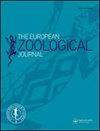避免生活在顶级捕食者附近:波兰东北部黑鹳和白尾鹰的共存
IF 1.6
4区 生物学
Q2 ZOOLOGY
引用次数: 2
摘要
黑鹳(Ciconia nigra)是一种栖息在湿地附近古林中的珍稀鸟类。21世纪初,波兰东北部的人口出现了倒退。由于观察到黑鹳数量的减少和白头鹰数量的增加之间存在相关性,我们验证了观察到的变化的一个重要原因是白尾鹰在研究区域的定居的假设。在长期监测的基础上,我们分析了黑鹳巢穴数量和分布的变化,并比较了白尾鹰在波兰最广阔的森林复群中对研究区域的殖民。1989年在研究区内发现了42个白鹳领地,而没有鹰。2019年,只有23对鹳,但鹰的数量增加到了13对。我们发现了黑鹳数量下降的速度和白尾鹰数量增加的速度之间的相关性。在研究的前半段,鹳的巢是随机分布的,之后它们变成了集群。随着时间的推移,巢的分布模式受到鹰数量增加的影响,这确保了鹳的巢聚集在离鹰巢更远的地方。同样,鹳巢的最近邻居距离取决于与鹰巢的距离和森林所占的领土份额。我们推测,鹳种群规模的变化主要是由鹰种群的增长引起的。鹳避免占据距离鹰巢不到4.6公里的巢穴。我们的研究表明,对捕食者的恐惧可能起到决定性作用。总的来说,必须得出结论,对顶级捕食者的保护可以以意想不到的方式影响其他共生物种。在Augustów森林(波兰东北部),黑鹳(Ciconia nigra)的数量在过去的30年里急剧下降,其巢穴的分布也从几乎单独的变为聚集的。白尾鹰(halaeetus albicilla)在研究区域的定居可能是观察到的变化的一个合理原因。白鹳避免占据距离白尾鹰巢穴4.6公里以内的巢穴,这个距离可以定义为安全距离。对捕食者的恐惧比直接捕食更能起到决定性的作用。本文章由计算机程序翻译,如有差异,请以英文原文为准。
The avoidance of living in the vicinity of a top predator: the coexistence of the black stork and the white-tailed eagle in NE Poland
Abstract The black stork Ciconia nigra is a rare species of bird that inhabits old forests near wetlands. The early 21st century has brought a regress of its population in north-eastern Poland. We verified the assumption that an important reason for the observed changes was the colonization of the study area by white-tailed eagle Haliaeetus albicilla, because we observed a correlation between decreasing numbers of the black stork and increasing numbers of the eagle. Based on the long-term monitoring, we analyzed changes in the numbers and distribution of the black storks’ nests and compared the colonization of the study area by the white-tailed eagle in the most extensive forest complex in Poland. We found 42 occupied territories of storks and no eagles in 1989 within the study area. In 2019, there were just 23 stork pairs, but the population of eagles increased to 13. We found a correlation between the rate of decline of the black storks population and the increase in the white-tailed eagles. In the first half of study period, storks’ nests have been distributed randomly, after which they became clustered. The pattern of nests distribution was influenced by the increase in the population of the eagle over time, with this ensuring the aggregation of the nests of storks in places more distant from the nests of eagles. Similarly, the nearest neighbor distance of storks’ nests was dependent on distances from the nests of eagles and the shares of territory accounted for by forests. We surmise that changes in the population size of storks were induced mainly by the growth of population of eagles. Storks avoided occupying nests less than 4.6 km from the eagles’ nests. Our study suggests that the determining role can be played by fear of the predator. Overall, it must be concluded that the protection of top predators can affect other co-occurring species in unexpected ways. Higlights In the Augustów Forest (north-eastern Poland), the number of the black stork Ciconia nigra over 30 years has strongly declined and the distribution of its occupied nests has changed from almost solitary to clustered. The colonization of the study area by the white-tailed eagle Haliaeetus albicilla was a plausible reason for the observed changes. Storks avoided occupying nests less than 4.6 km from the white-tailed eagles’ nests, which can be defined as a safety distance. The determining role can be played by the fear of the predator more than by direct predation.
求助全文
通过发布文献求助,成功后即可免费获取论文全文。
去求助
来源期刊

European Zoological Journal
Agricultural and Biological Sciences-Animal Science and Zoology
CiteScore
3.10
自引率
5.60%
发文量
80
审稿时长
30 weeks
期刊介绍:
The European Zoological Journal (previously Italian Journal of Zoology) is an open access journal devoted to the study of all aspects of basic, comparative and applied protozoan and animal biology at molecular, cellular, tissue, organ, organismal, population, and community-ecosystem level. Papers covering multiple levels of organization and integrative approaches to study animal form, function, development, ecology, evolution and systematics are welcome. First established in 1930 under the name of Il Bollettino di Zoologia, the journal now has an international focus, reflected through its global editorial board, and wide author and readership.
 求助内容:
求助内容: 应助结果提醒方式:
应助结果提醒方式:


